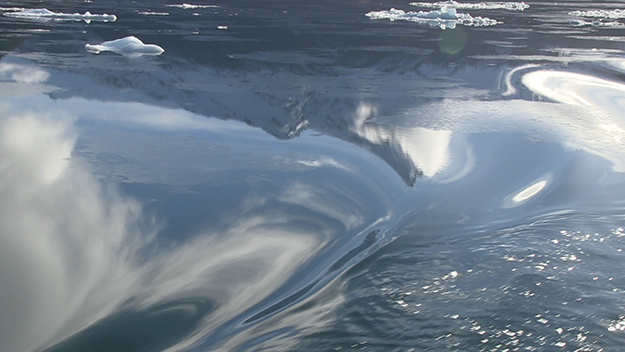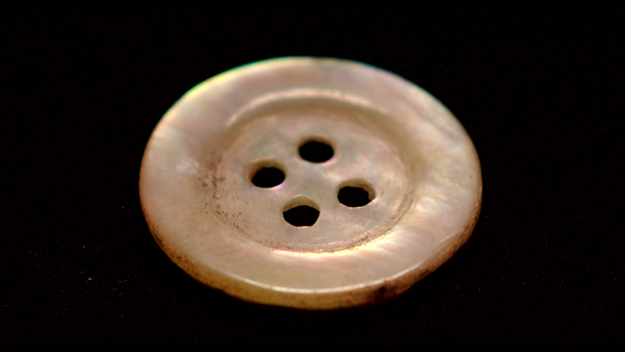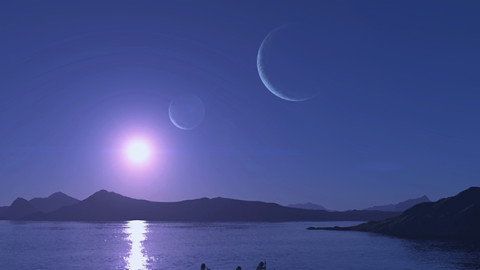Film of the Week: The Pearl Button

Chilean documentarist Patricio Guzmán is currently making his films under the banner Atacama Productions, named after the vast Atacama Desert in the north of his home country. The desert is apparently the single most arid place on earth, but for Guzmán, it has proved a most fertile source of metaphor. In his 2010 film Nostalgia for the Light, Guzmán studied the radio telescopes that have been installed in Atacama. Musing on astronomy’s status as a Chilean national obsession of sorts, he asked why his nation is so fascinated with looking millions of years into the past, gazing at stars that are long dead by the time we see them—and yet reluctant to consider its own recent past, the brutal days of the Pinochet regime. In a powerfully suggestive chain of associations, Guzmán turned his attention to people who are gazing deep into two pasts at once: searching the ancient sands of Atacama for the bones of dead relatives, dumped there by their government torturers and murderers in Chile’s blackest period.
Guzmán now follows Nostalgia, a film made under the sign of dryness, with its counterpart, a contemplation of water. The Pearl Button begins with a block of quartz crystal, seen in close-up: it contains a single drop of water, itself a glistening pearl button of sorts. During its long opening stretch, the film lingers on the mystery and allure of H2O—we see a slowly glittering image that may be of light on a lake surface, or of stars in space, accompanied by the sound of aqueous trickles. The tone is eerie, impressionistic and—not to put too fine a point on it—more than a little New Age, not least because of Guzmán’s airy, incantatory voice, which somewhat suggests a more naïve, impressionable Latin American cousin to Werner Herzog in his prophetically exalted mode.
Guzmán then revisits the Atacama telescopes, and reminds us that water originally came to Earth from the distance of space. “Water,” he tells us, “is an intermediary force between the stars and us.” We are starlight, and all that—furthermore, he comments, “The law of thought is the same as that of water, that is, always ready to adapt to everything.” We see mountains of blue ice, like giant mints, and the cracking sound as they slowly melt. We are told how the western cordillera of the Andes was submerged by water to become islands; we get a flyover of the Chilean coast, aerial shots recalling the work of photographer Yann Arthus-Bertrand. It’s all beautiful and quite awe-inspiring, although you sometimes yearn for the commonsensical pedagogic tone of a David Attenborough TV series.
After a while, though, things get more specific: Guzmán is interested in the fact that Chile is a country with little naval history and little interest, he claims, in the sea. This despite a 4,200-kilometer coastline that is practically impossible to depict on normal-scaled maps: artist Emma Malig has recreated it as a huge parchment to be unrolled in a long studio. On school maps, we hear, it was traditional for Chile to be shown in three parts, like three separate countries (you get a glimpse here of the strangeness of the Chilean cultural imagination evoked in recent autobiographical reminiscences of childhood by Raúl Ruiz and Alejandro Jodorowsky, respectively Night Across the Street and The Dance of Reality).
There were Chileans who once belonged to the sea—the indigenous tribes of Patagonia. Now, however, says one member of Chile’s vastly reduced indigenous population, Martin Calderón—who remembers rounding Cape Horn with his father at the age of 12—“We are barely allowed in the sea.” The Chilean navy, he says, claims it is protecting the indigenous people, but is really cutting them off from their ancient traditions. Much of The Pearl Button is about those ruined tribes, such as the Kaweskar and the Selknam—the latter traditionally inscribing their bodies with dots and lines depicting the cosmos, in accordance with their belief that after death, we all become stars.

It’s with the outline of these people’s history that Guzmán’s film takes a harder tack, as we hear how their existence came to an end; the arrival in Chile in 1883 of settlers, gold hunters, missionaries, and their ilk marked the end of their world. In a story that sounds all too similar to those of North American or Antipodean indigenous peoples, we hear how the Patagonians were killed in several ways: first accidentally, by being made to wear Western clothes that carried bacteria that their bodies could not handle; then deliberately, with a program of extermination, with bounty hunters paid lucratively for body parts. It’s a hideous narrative that causes Guzmán to seek consolation by retreating into a utopian science-fiction reverie of how things might have been, as he imagines some other planet being a refuge for these “water Indians,” as he calls them. This thought is accompanied by a fanciful image of a canoe on water under a night sun and two moons—a CGI equivalent of certain paperback covers of the Seventies, at a time when the mystical likes of Carlos Castaneda held sway over the imaginations of science-fiction illustrators.
Guzmán has another science-fiction image in mind—time travel—when it comes to the story behind the film’s title. One indigenous man—a “Fuegian,” from Tierra del Fuego—has gone down in history by the name “Jemmy Button.” He was bought for the price of a pearl button by an explorer, Captain Robert FitzRoy, who took the young man back home with him to visit Britain in 1830. Jemmy later returned to his own country—an overall experience that, unsurprisingly, proved brutally traumatic for him. Guzmán describes him as having “traveled thousands of years into the future . . . and thousands of years into the past . . . from Stone Age to Industrial Revolution”—a questionable formulation that somewhat undermines the claims Guzmán makes for the Fuegians’ cultural sophistication and complexity.
We then learn that Salvador Allende, Chile’s president in the early Seventies, started to restore confiscated land to the indigenous peoples—a program cut short by the coup that deposed him and put Augusto Pinochet in his place. Here we get into a familiar theme of Guzmán’s cinema, and the one that directly connects this film with Nostalgia for the Light. Earlier on in the film, he remembers a school friend who was swept away by waves, and calls him “my first ‘disappeared person.’” The later parts of The Pearl Button reveal the distressing connections between the sea and the multitudes of Chileans who were “disappeared” during the Pinochet years. Most shocking of all is a black-and-white photo of a woman named Marta Ugarte, fished out of the sea; she was thrown in after torture, and the picture shows her eyes open, fixed in a ghastly stare, witness to God knows what horrors.
We learn that many of the dictator’s opponents were tortured supposedly to extract information, although the authorities had that information already; the brutality is all the more shocking for its gratuitousness. But here’s perhaps the grimmest revelation, with the exquisite touch of the refined science of torture: a reconstruction shows a particular technique in which a heavy rail, weighing at least 30 kilos, would be placed on the chest of each prisoner, who would then be carefully wrapped in a bag before being dropped into the sea by helicopter.

And now the connection that ties together all the film’s threads: just as people were seen in Nostalgia searching for the dead in the desert sand, so here we see divers inspecting the sea bed for the sunken rails. One is hauled up from the deep—you’re tempted to see this as a horrific metaphor for bringing the hidden past back to the surface, although in its devastating literalness, we’re not dealing with a metaphor at all. And on that rail is found… a pearl button, a remnant from the clothing of one drowned torture victim.
So the pearl button links two histories of systematic extermination, a century apart. And the image of the button implicit in that droplet at the start, suspended in quartz, allows Guzmán, a Jules Verne fan in childhood, to slip into otherworldly flights of imagination that perhaps take the sting out of the crueler stories that he has to tell. Commenting on the discovery of a quasar holding 120 million times more water than all the Earth’s seas, Guzmán wonders: “How many wandering souls might find refuge in this vast ocean that’s drifting in the void?” There’s an undeniable tinge of kitsch in this film’s visual beauty and poetic language that wasn’t evident in the far tauter Nostalgia for the Light—but, taken as part of a diptych, The Pearl Button has no shortage of documentary force or of imaginative seriousness. Dealing with horrors of this intensity and scale, Guzmán can be forgiven a slight penchant for the galactically vaporous.




